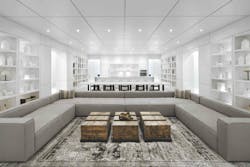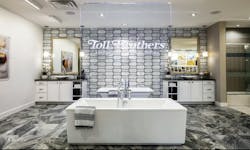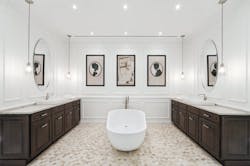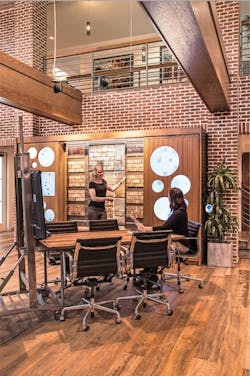With design sophistication and high expectations to match, today’s homebuyers aren’t like they used to be. Design centers, now also called design studios, need to keep pace. Spaces that are customer-focused and make the wealth of interconnected decisions as easy as possible show customers that the builder cares about creating a unique, personalized home.
While it’s easy to find stunning design studios, that’s not enough, says Jane Meagher, president of Success Strategies, a design studio consulting firm in Manalapan, N.J. Meagher says there must be an underlying strategy. “Our slogan is that pretty is great, but smart is better. Have both,” she says.
For consumers, saving images from Pinterest, Houzz, and design blogs has replaced the practice of tearing pages out of magazines. Buyers have more choices than ever, and they can do plenty of online research ahead of time. As a result, they’re aware of available design and floor plan options, and they arrive at the studio knowing what they want, says Mary DeWalt, president of Austin, Texas-based interior merchandising firm Mary DeWalt Design Group.
Design Center 101
All of the experts we talked to for this article agree that a design center’s function is far from just being a venue for placing orders. There’s been an evolution in what a design studio contributes to the process of creating a new home, says Lita Dirks, CEO of Lita Dirks & Co., an interior design and merchandising firm in Greenwood Village, Colo.
A design studio need not be large, but it should be well-thought-out, Dirks says, “to show the builder cares about the choices buyers need to make when purchasing a home from them.” A design studio is much more than simply a place to look at samples. Here are tips to help ensure a design center delivers the maximum return on investment.
1. Know your target market
Mary DeWalt, of Mary DeWalt Design Group, advises studying buyer preferences and psychographics. Understand that consumers are more sophisticated than they used to be.
2. Think collaboratively
A design studio needs to be efficient for both the consumer and for the builder’s rep who’s working there, Dirks says. Creating a design studio is a team effort that must be collaborative.
3. Be consistent
The design studio is another consumer touch point with the builder’s brand, so make sure it supports that brand, says Jane Meagher, of Success Strategies.
4. Provide food and a comfortable place to relax
Dirks says decision-making is arduous and emotionally hard on the buyer, so it helps if they have a comfortable place to take a break before they continue.
5. Show only what’s for sale
Everything displayed in a design studio or model home should be available to the buyer, DeWalt says. “You don’t want to disappoint.”
6. Provide white space
It can be a slanted board or some other surface with a light background, so homebuyers can easily view their choices, Dirks says.
7. Keep the focus on the consumer
It’s not about the builder, says Deb Schrade, former design and décor manager for Brookfield Residential. Stay on the leading edge of design trends while being aware of the bottom line.
8. Invest in the team
Hire people who can create a great experience, says Leigh Spicher, home builder Ashton Woods’ national director of design studios. You can have exceptional design and beautiful spaces, but without staff who genuinely care about happy homeowners, it won’t happen.
RELATED
- The Future of the New-Home Design Studio
- Home Builders' Design Studios Go for a Retail Spin
- A Fresh Take on Model Homes
Think Like a Consumer, Act Like a Retailer
The design studio is an investment that must make a return for the builder. “We look at the experience you want the customer to have and also plan for how best to provide a return for the floor space,” Meagher says. “There must be a positive return on investment,” she insists. “A studio needs to show its own profit and loss and how it can be quantifiably measured, with incremental profits on sales.”
Meagher says that when a builder’s volume is increasing every year, the incremental profit it can make on each sale can significantly affect the bottom line. For example, if a builder is selling 250 homes per year and the design studio was able to implement improvements to deliver an additional $5,000 in incremental option sales for every buyer, that would represent about $1.2 million in incremental revenue. If the average profit margin is 30 to 35 percent, that would be an increase of between $375,000 and $437,500 in incremental profit in a year—not to mention the better buyer experience and ability to use the studio to increase home sales, she says.
There are also other metrics to consider, Meagher says, such as whether the customer experience leads to referrals and increased home sales. Or, if a prospective customer comes to the design studio before they purchase the home and then returns to the builder based on their positive impression, the studio has converted a prospect into a buyer.
“A design studio is a store that’s owned by the builder, so we tell [builders] to think like a consumer but act like a retailer. A strong retailer thinks strategically about how a buyer proceeds through the store.” —Jane Meagher, president, Success Strategies
A homebuyer has to make multiple and interrelated decisions all at one time. To improve this potentially exhausting process, Meagher offers this advice to builders: “A design studio is a store that’s owned by the builder, so we tell [builders] to think like a consumer but act like a retailer. A strong retailer thinks strategically about how a buyer proceeds through the store.” She adds, “It’s not just putting products on racks. It’s creating an experience that puts people in the mood to buy.”
Design centers have come a long way, and Meagher finds it exciting that they’re now an up-front part of prospective buyers’ purchasing process. Time was, few builders leveraged the design studio as a tool for buying from them, and builders subsequently missed the opportunity to make this experience a compelling, unique selling proposition for their brand. “But today, the industry understands how much a studio can offer and what a strong component it is as part of the business model,” Meagher says.
Design studios illustrate an evolution from the days when they were often considered to be little more than order centers. The following four builders recognize the inherent value of their design centers—and the ensuing opportunities they create—and their studios offer function, beauty, a great customer experience, and a return on investment.
Toll Brothers: Memorable Customer Experience
The centralized design center that services Toll Brothers’ Las Vegas division shows that a memorable customer experience and return on investment are two important reasons to invest in a stellar design studio. “It doesn’t take much to make a 5 percent option sales increase that has a massive impact on the bottom line,” Meagher says.
Building luxury communities since 1967, Toll Brothers offers a design center experience that aims to be as high-end as its built offerings. Its home types include traditional luxury, active-adult, and active-living communities, as well as urban residences, premier student living, luxury rentals, and resort-style communities. Headquartered in Horsham, Pa., Toll Brothers is currently building homes in 50 markets across 20 states.
The builder also operates 26 design studios across the country whose top priority is to provide an exceptional customer experience. New homes are personalized with a wide variety of choices from some of the industry’s top-quality brands. This can be overwhelming for the buyer, but a visit to the design studio website sets the stage for what’s to come, according to Lisa McClelland, Toll Brothers’ VP of design studios. With online tools and resources, a customer can even get pre-appointment advice regarding what to expect on the first visit, which the builder recommends as a chance to see and touch products and start gathering ideas.
On site, there’s a showcase of design options, from classics to the latest trends, but also tips for how personal style can be identified. And customers can browse through photo galleries of different room vignettes, illustrating what’s available in a specific region of the country.
Because making such choices is a tactile process, there are also several professionally decorated model homes that display many of the options shown in the studio, giving homebuyers an idea of the selections they’ll be making. Although technology plays a part in design choices, McClelland says Toll takes pride in personally helping its customers to see, touch, and select the products for their home. “We consider the customer’s experience and satisfaction with the design studio as a key point in their buying journey and overall experience with our brand,” she says. “A positive experience is the best return on investment.”
Ashton Woods: Beyond Decorating
Headquartered in Atlanta, Ashton Woods builds homes in Georgia, South Carolina, Texas, Arizona, Florida, and North Carolina. The builder decided to make sure its overall approach was reflected in its 10 studios, according to Leigh Spicher, the builder’s national director of design studios. “We wanted to better identify challenges to the consumer when building a home, and not just an ordinary home, but a personal one,” she says.
The goal was to bring real design—not just decorating—to homebuyers, as well as access to design principles and creative finishes, Spicher says. It’s not the order-taking process that some people think it is, she adds. When buyers purchase a home from Ashton Woods, “they’ve just purchased beautiful architecture, but now it’s time to talk about how they want to live in that home. We’re a production builder, but we personalize each home for the buyer,” she says.
Before creating its design studios, Spicher says Ashton Woods talked with consumers. And it learned just how stressful the design studio process could be. To lessen the pressure, design center consultants reach out to their customers beforehand and put together a palette based on what they learn, which gives them a place to start when the homebuyer comes in. “Making the decision to buy a home can be stressful, but decorating it should be the fun part,” Spicher notes.
Designers meet buyers at the door and offer a cup of coffee, with nothing to buy or decide on in sight. They then sit with buyers and spend time getting to know them, which sends the message that the design center experience is going to be a personalized one. Next, buyers view vignettes of different rooms presented according to style and price point.
Life-size vignettes, ample space to view samples, and a team of gifted designers go a long way. But Spicher says that Ashton Woods also continually seeks innovative products from around the world. She also credits buyers as inspiration for the space that will foster personalization in the home. “We want to bring good design to everyone and dispel the myth that building a home is stressful,” she says.
Brookfield Residential: Decision-Making Expertise
A proliferation of design blogs, home improvement websites, and shelter television shows means most homebuyers come into a studio today armed with a combination of design knowledge and high expectations.
In 2016, Fairfax, Va.-based Brookfield Residential opened the on-site design center at its Kissing Tree 55-plus community located 30 miles south of Austin, Texas, in San Marcos. To match the design savvy of its homebuyers, the Brookfield team at Kissing Tree ensures it’s just as prepared: By the time customers arrive for their appointment at the studio, the builder has made sure the buyer understands the process, and products are on display so buyers can come in seven days a week and browse at their own pace.
Design centers used to be closed-door places, but Brookfield keeps it open and relaxed, says Deb Schrade, former design and décor manager. “We’re here to share our expertise and product knowledge to help homebuyers make the best decisions,” she says. “We make it fun, and our services are always tailored to the buyer.”
Building a home isn’t always smooth sailing between partners, and that’s no different when choosing design elements, Schrade says. Design center managers who are well-trained can even step into the role of counselor, if needed. If someone is getting overwhelmed, the designer simply slows things down. Thanks to monthly design and product training sessions, Kissing Tree staff know there’s always another option. “After we understand what the [homebuyer is] leaning toward, we can bring over some choices and pare it down to four or five. Simplifying the decision helps,” Schrade says.
Edward Andrews Homes: Digital Advantage
“Most psychologists rank building a home as one of the top five stressors,” says Brian Parker, associate principal at Atlanta-based design firm Cooper Carry. When designing a new studio for Edward Andrews Homes, the firm believed that the space needed to reflect the atmosphere of comfortable Southern hospitality, rather than the homes themselves. “That’s why this project evokes a very genteel, relaxed environment—almost home-like,” Parker says.
It didn’t stop there. Looking for a fresh take on the builder showroom, the Atlanta-based builder wanted its 7,000-square-foot studio to be almost exclusively digital. The studio trades traditional vignettes for technology-based 3-D visualization. This also makes for a streamlined decision-making process.
The advantages of a digital approach, Parker says, is that unlike vignettes that would have to be redone over time, the studio can show more options to homebuyers, increasing engagement. A digital system allows homebuyers to choose elements and send them to the designer before their meeting. Design software allows for products, such as cabinets, to be moved around in the space until the customer is satisfied.
Parker concedes that there will always be a physical element to the selections process—samples are still important—but maintains that digital makes it more efficient because customers no longer need to walk through different areas, choosing from products in a variety of locations throughout the space.
Because technology plays a central role in the design studio experience, creating a warm and comfortable physical surrounding was a top priority, Parker says. “The room could have come across as cold and technocentric, but it needed to be aesthetically pleasing. The challenge was to create an inviting space that reflects the high-end homes that Edward Andrews builds, juxtaposed with all the technology.”
Debbie Reslock is a certified planner and freelance writer based in Evergreen, Colo.




